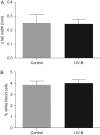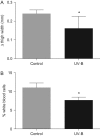Early exposure to ultraviolet-B radiation decreases immune function later in life
- PMID: 27668081
- PMCID: PMC5033135
- DOI: 10.1093/conphys/cow037
Early exposure to ultraviolet-B radiation decreases immune function later in life
Abstract
Amphibians have declined dramatically worldwide. Many of these declines are occurring in areas where no obvious anthropogenic stressors are present. It is proposed that in these areas, environmental factors such as elevated solar ultraviolet-B (UV-B) radiation could be responsible. Ultraviolet-B levels have increased in many parts of the world as a consequence of the anthropogenic destruction of the ozone layer. Amphibian tadpoles are particularly sensitive to the damaging effects of UV-B radiation, with exposure disrupting growth and fitness in many species. Given that UV-B can disrupt immune function in other animals, we tested the hypothesis that early UV-B exposure suppresses the immune responses of amphibian tadpoles and subsequent juvenile frogs. We exposed Limnodynastes peronii tadpoles to sublethal levels of UV-B radiation for 6 weeks after hatching, then examined indices of immune function in both the tadpoles and the subsequent metamorphs. There was no significant effect of UV-B on tadpole leucocyte counts or on their response to an acute antigen (phytohaemagglutinin) challenge. However, early UV-B exposure resulted in a significant reduction in both metamorph leucocyte abundance and their response to an acute phytohaemagglutinin challenge. These data demonstrate that early UV-B exposure can have carry-over effects on later life-history traits even if the applied stressor has no immediately discernible effect. These findings have important implications for our understanding of the effects of UV-B exposure on amphibian health and susceptibility to diseases such as chytridiomycosis.
Keywords: Amphibian declines; disease; immunocompetence; leucocyte; phytohaemagglutinin; ultraviolet radiation.
Figures




References
-
- Alford RA, Richards SJ (1999) Global amphibian declines: a problem in applied ecology. Annu Rev Ecol Syst 30: 133–165.
-
- Alton LA, Wilson RS, Franklin CE (2010) Risk of predation enhances the lethal effects of UV-B in amphibians. Glob Change Biol 16: 538–545.
-
- Alton LA, White CR, Wilson RS, Franklin CE (2012) The energetic cost of exposure to UV radiation for tadpoles is greater when they live with predators. Funct Ecol 26: 94–103.
-
- Ankley GT, Diamond SA, Tietge JE, Holcombe GW, Jensen KM, DeFoe DL, Peterson R (2002) Assessment of the risk of solar ultraviolet radiation to amphibians. I. Dose-dependent induction of hindlimb malformations in the Northern leopard frog (Rana pipiens). Environ Sci Technol 36: 2853–2858. - PubMed
LinkOut - more resources
Full Text Sources
Other Literature Sources

